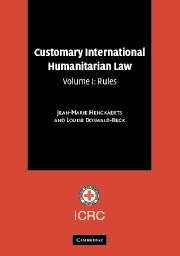Book contents
- Frontmatter
- Contents
- Foreword by ICRC President Jakob Kellenberger
- Foreword by Judge Abdul G. Koroma
- Foreword by Yves Sandoz
- Acknowledgements
- Introduction
- List of abbreviations
- Part I The Principle of Distinction
- Part II Specifically Protected Persons and Objects
- Part III Specific Methods of Warfare
- Part IV Weapons
- Part V Treatment of Civilians and Persons Hors De Combat
- Chapter 32 Fundamental Guarantees (Rules 87–105)
- Chapter 33 Combatants and Prisoner-of-War Status (Rules 106–108)
- Chapter 34 The Wounded, Sick and Shipwrecked (Rules 109–111)
- Chapter 35 The Dead (Rules 112–116)
- Chapter 36 Missing Persons (Rule 117)
- Chapter 37 Persons Deprived of Their Liberty (Rules 118–128)
- Chapter 38 Displacement and Displaced Persons (Rules 129–133)
- Chapter 39 Other Persons Afforded Specific Protection (Rules 134–138)
- Part VI Implementation
Chapter 35 - The Dead (Rules 112–116)
Published online by Cambridge University Press: 05 June 2012
- Frontmatter
- Contents
- Foreword by ICRC President Jakob Kellenberger
- Foreword by Judge Abdul G. Koroma
- Foreword by Yves Sandoz
- Acknowledgements
- Introduction
- List of abbreviations
- Part I The Principle of Distinction
- Part II Specifically Protected Persons and Objects
- Part III Specific Methods of Warfare
- Part IV Weapons
- Part V Treatment of Civilians and Persons Hors De Combat
- Chapter 32 Fundamental Guarantees (Rules 87–105)
- Chapter 33 Combatants and Prisoner-of-War Status (Rules 106–108)
- Chapter 34 The Wounded, Sick and Shipwrecked (Rules 109–111)
- Chapter 35 The Dead (Rules 112–116)
- Chapter 36 Missing Persons (Rule 117)
- Chapter 37 Persons Deprived of Their Liberty (Rules 118–128)
- Chapter 38 Displacement and Displaced Persons (Rules 129–133)
- Chapter 39 Other Persons Afforded Specific Protection (Rules 134–138)
- Part VI Implementation
Summary
Rule 112. Whenever circumstances permit, and particularly after an engagement, each party to the conflict must, without delay, take all possible measures to search for, collect and evacuate the dead without adverse distinction.
Practice
Volume II, Chapter 35, Section A.
Summary
State practice establishes this rule as a norm of customary international law applicable in both international and non-international armed conflicts.
International armed conflicts
The duty to search for the dead in international armed conflicts was first codified in the 1929 Geneva Convention for the Amelioration of the Condition of the Wounded and Sick in Armies in the Field. This rule is now codified in the 1949 Geneva Conventions.
Numerous military manuals specify the duty to search for and collect the dead. In the Jenin (Mortal Remains) case in 2002, Israel's High Court of Justice stated that locating the dead was a “highly important humanitarian deed”.
Non-international armed conflicts
In the context of a non-international armed conflict, the duty to search for the dead is set forth in Additional Protocol II. In addition, this rule is contained in other instruments pertaining also to non-international armed conflicts.
A number of military manuals which are applicable in or have been applied in non-international armed conflicts specify the duty to search for and collect the dead.
Respect for this rule is a conditio sine qua non of respect for the subsequent rules in this chapter requiring return of remains, decent burial and identification of the dead.
- Type
- Chapter
- Information
- Customary International Humanitarian Law , pp. 406 - 420Publisher: Cambridge University PressPrint publication year: 2005

